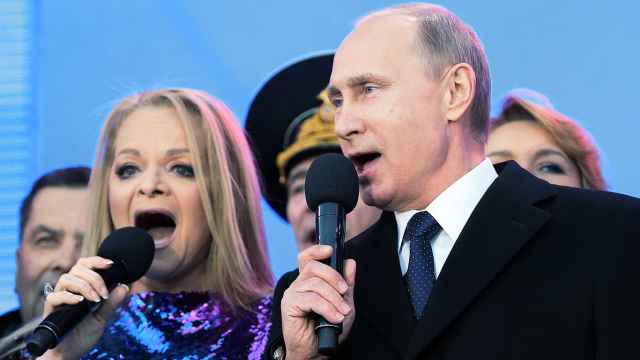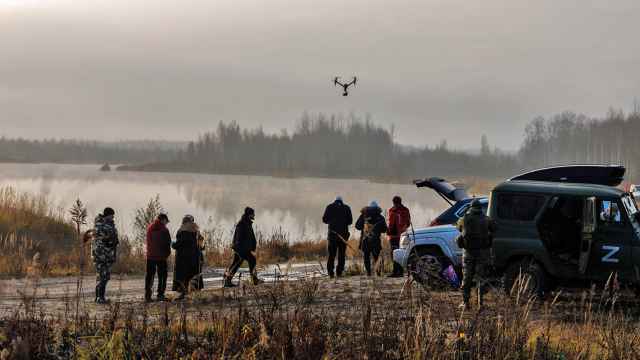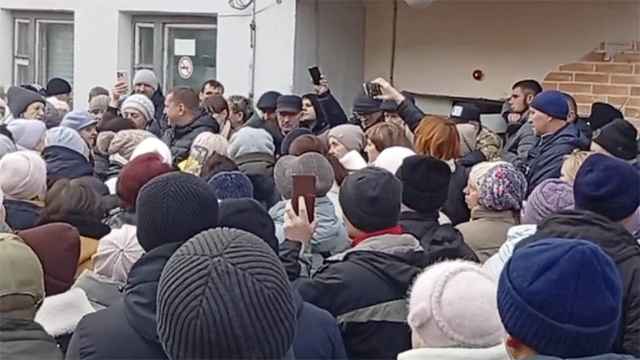Twenty-five years ago last week a nondescript railcar rolled away from the Votkinsk Machine Building Factory in the Ural Mountains. Inside was one of the Soviet Union's finest intercontinental ballistic missiles, heading off to be armed with a warhead, join its mobile unit and most likely be targeted at the United States.
And yet that weapon of mass destruction and the attention it received epitomized the cooperative spirit of the superpowers and could serve as a reminder to today's leaders of what the two countries can achieve together.
The missile's departure from the portal monitoring facility run by American inspectors working under the Intermediate Range Nuclear Forces (INF) treaty marked a rare low point in the implementation of that agreement.
The so-called "Votkinsk missile crisis" of March 1990 stemmed from a disagreement between the two sides as to the readiness of a U.S.-made oversized X-ray machine called CargoScan. This machine was supposed to scan every departing railcar containing a missile to ensure it was an ICBM and not an intermediate range SS-20 that had been banned by the treaty.
CargoScan was the only element of verification behind schedule — due to its technical complexity and the extensive process of hammering out the finer points of treaty implementation. Political pressure had been mounting in Washington from hawks like Senator Jesse Helms, who had opposed INF and the detente that was taking place and were using the CargoScan delay as an example of why peace was not verifiable.
But treaty implementation was being carried out successfully in both countries — Votkinsk's sister site under INF was the Hercules plant in Magna, Utah. In addition to factory monitoring, inspection teams observed the elimination of missiles and spontaneously checked former launch sites. But because Votkinsk was still allowed to make larger missiles, CargoScan played a particularly visible role in the "trust but verify" doctrine.
In February the Americans had declared the system was ready and any missile exiting the factory now must undergo a scan. The Soviets, still getting used to the unprecedented invasiveness of mutual verification — including having 30 Americans living at the front gate of one of the country's most important secret factories — did not agree.
They had concerns about its operating parameters and were wary of how the powerful X-ray would affect the solid fuel of the missile and what design details it might reveal.
On March 1, when the gray six-axle railcar exited the factory gate, we knew there would be a conflict.
Ominously, as we shimmied along the canister inside the railcar to measure its length and diameter, the lighting briefly failed. I remember standing in the dark, inhaling the tart smell of the fresh green paint, wondering if the frantically communicating diplomats would be able to reach a compromise.
The White House asked the Kremlin for a time-out. It was agreed to move the missile car into the nearby inspection building.
The drama hardly corresponded to the hysterical claims made by Robert Evans and Rowland Novak of The Washington Post — that the Soviet guards "drew their pistols against unarmed U.S. technicians." Railcars with missiles were always accompanied by two soldiers carrying standard-issue Kalashnikovs (not pistols), and they never pointed them at anyone.
While waiting for a resolution to the impasse, we kept joint watch over the railcar inside the building. The guards even placed their weapons on the floor while we tossed around a Nerf football.
The Soviet side had its own pressures to deal with. The week prior, the revered former director of the factory had shot himself in the head, defeated by Parkinson's disease and his inability to adjust to perestroika. And the factory's customer, the Defense Ministry, had made it clear that there would be fines for any delivery delays.
The Soviets told the Americans the amount owed now stood at $27,000 and asked, only half-jokingly, if they would help foot the bill. But it was a serious concern for factory management. Votkinsk is a single-industry town where everyone depends on the industrial concern for their livelihood.
Because the previous two years of joint treaty work had gone smoothly, Washington had formally delegated full decision making authority to the inspection team in Votkinsk.
On Friday, March 9, the U.S. site commander requested that the Soviets "pop the lid" of the canister so we could visually inspect the missile itself — the next best thing to a scan under the terms of the treaty.
The rear doors of the railcar were opened. That paint smell filled the air as the top of the canister was removed.
We shined our flashlights along the length of the monster inside. The three stages confirmed that it appeared to be an SS-25, and not its 2-stage, now-forbidden younger brother. The Soviets removed the railcar from the building and again demanded we agree to allow the missile to depart unscanned.
A full moon glinted off the rails as the car began to roll down the tracks into the darkness of the woods. I will never forget that at that very moment a black cat scampered out from underneath the railcar and also disappeared into the night.
The omen was premature. The Americans declared the incident a treaty "ambiguity," not a violation. Defense officials from both sides descended on our outpost the following week and ironed out all the remaining differences. By the end of the month missiles were being scanned in accordance with the treaty.
Despite detractors on both sides, a long history of mistrust and conflicting national interests, INF came to be and was the foundation for further arms control efforts, like the Strategic Arms Reduction Treaty (START). It also fostered a culture of cooperation for an entire generation of diplomats, defense officials and contractors over the next two decades. Now we find ourselves frustrated and disappointed. Why has this spirit faded instead of grown?
The treaty was born thanks to the work of giants: U.S. President Ronald Reagan and Soviet leader Mikhail Gorbachev, U.S. Secretary of State George P. Shultz and Soviet Foreign Minister Eduard Shevardnadze, and Ambassadors Jack F. Matlock and Yury Dubinin.
Their work was driven by a clear understanding: war — cold or not — is unacceptable; rhetoric and posturing are not a path to achieving anything; mutual accusation and criticism in the media lead nowhere. What has changed that makes these fundamental values that worked 25 years ago invalid now?
Issues like terrorism and proliferation, which both countries are facing, are more complex and insidious than anything in the past. Today's leaders at all levels need to step back and study history. Then there is a chance they can return to the common ideals and mutual respect the giants at the end of the last century found.
Justin Lifflander was an inspector for the Intermediate Range Nuclear Forces Treaty and later business editor at The Moscow Times. He is the author of "How Not to Become a Spy: A memoir of love at the end of the Cold War" (Gilbo Shed, 2014).
A Message from The Moscow Times:
Dear readers,
We are facing unprecedented challenges. Russia's Prosecutor General's Office has designated The Moscow Times as an "undesirable" organization, criminalizing our work and putting our staff at risk of prosecution. This follows our earlier unjust labeling as a "foreign agent."
These actions are direct attempts to silence independent journalism in Russia. The authorities claim our work "discredits the decisions of the Russian leadership." We see things differently: we strive to provide accurate, unbiased reporting on Russia.
We, the journalists of The Moscow Times, refuse to be silenced. But to continue our work, we need your help.
Your support, no matter how small, makes a world of difference. If you can, please support us monthly starting from just $2. It's quick to set up, and every contribution makes a significant impact.
By supporting The Moscow Times, you're defending open, independent journalism in the face of repression. Thank you for standing with us.
Remind me later.







